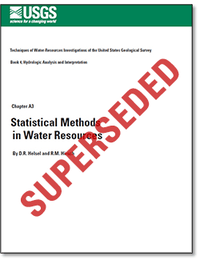Statistical Methods in Water Resources
Links
- Document: Report (9.39 MB pdf)
- Errata: Errata Sheet (6.15 KB pdf)
- Superseding Publications:
- Download citation as: RIS | Dublin Core
Preface
This book began as class notes for a course we teach on applied statistical methods to hydrologists of the Water Resources Division, U. S. Geological Survey (USGS). It reflects our attempts to teach statistical methods which are appropriate for analysis of water resources data. As interest in this course has grown outside of the USGS, incentive grew to develop the material into a textbook. The topics covered are those we feel are of greatest usefulness to the practicing water resources scientist. Yet all topics can be directly applied to many other types of environmental data.
This book is not a stand-alone text on statistics, or a text on statistical hydrology. For example, in addition to this material we use a textbook on introductory statistics in the USGS training course. As a consequence, discussions of topics such as probability theory required in a general statistics textbook will not be found here. Derivations of most equations are not presented. Important tables included in all general statistics texts, such as quantiles of the normal distribution, are not found here. Neither are details of how statistical distributions should be fitted to flood data -- these are adequately covered in numerous books on statistical hydrology.
We have instead chosen to emphasize topics not always found in introductory statistics textbooks, and often not adequately covered in statistical textbooks for scientists and engineers. Tables included here, for example, are those found more often in books on nonparametric statistics than in books likely to have been used in college courses for engineers. This book points the environmental and water resources scientist to robust and nonparametric statistics, and to exploratory data analysis. We believe that the characteristics of environmental (and perhaps most other 'real') data drive analysis methods towards use of robust and nonparametric methods.
Exercises are included at the end of chapters. In our course, students compute each type of analysis (t-test, regression, etc.) the first time by hand. We choose the smaller, simpler examples for hand computation. In this way the mechanics of the process are fully understood, and computer software is seen as less mysterious.
We wish to acknowledge and thank several other scientists at the U. S. Geological Survey for contributing ideas to this book. In particular, we thank those who have served as the other instructors at the USGS training course. Ed Gilroy has critiqued and improved much of the material found in this book. Tim Cohn has contributed in several areas, particularly to the sections on bias correction in regression, and methods for data below the reporting limit. Richard Alexander has added to the trend analysis chapter, and Charles Crawford has contributed ideas for regression and ANOVA. Their work has undoubtedly made its way into this book without adequate recognition.
Professor Ken Potter (University of Wisconsin) and Dr. Gary Tasker (USGS) reviewed the manuscript, spending long hours with no reward except the knowledge that they have improved the work of others. For that we are very grateful. We also thank Madeline Sabin, who carefully typed original drafts of the class notes on which the book is based. As always, the responsibility for all errors and slanted thinking are ours alone.
Suggested Citation
Helsel, D.R. and R. M. Hirsch, 2002. Statistical Methods in Water Resources Techniques of Water Resources Investigations, Book 4, chapter A3. U.S. Geological Survey. 522 pages.
Table of Contents
- Preface
- Chapter 1. Summarizing Data
- Chapter 2. Graphical Data Analysis
- Chapter 3. Describing Uncertainty
- Chapter 4. Hypothesis Tests
- Chapter 5. Differences between Two Independent Groups
- Chapter 6. Matched-Pair Tests
- Chapter 7. Comparing Several Independent Groups
- Chapter 8. Correlation
- Chapter 9. Simple Linear Regression
- Chapter 10. Alternative Methods for Regression
- Chapter 11. Multiple Linear Regression
- Chapter 12. Trend Analysis
- Chapter 13. Methods for Data Below the Reporting Limit
- Chapter 14. Discrete Relationships
- Chapter 15. Regression for Discrete Responses
- Chapter 16. Presentation Graphics
- References Cited
- Appendix A. Construction of Boxplots
- Appendix B. Tables
- Appendix C. Data Sets
- Appendix D. Answers to Selected Exercises
- Index
| Publication type | Report |
|---|---|
| Publication Subtype | USGS Numbered Series |
| Title | Statistical methods in water resources |
| Series title | Techniques of Water-Resources Investigations |
| Series number | 04-A3 |
| DOI | 10.3133/twri04A3 |
| Edition | Version 1.1 |
| Publication Date | September 01, 2002 |
| Year Published | 2002 |
| Language | English |
| Publisher | U.S. Geological Survey |
| Publisher location | Reston, VA |
| Description | 522 p. |
| Public Comments | Techniques of Water-Resources Investigations, book 4, chapter A3, version 1.1 is superseded by Techniques and Methods 4-A3. |
| Online Only (Y/N) | Y |
| Additional Online Files (Y/N) | Y |


